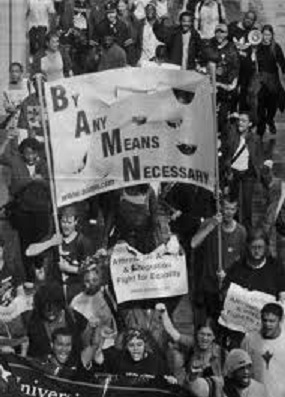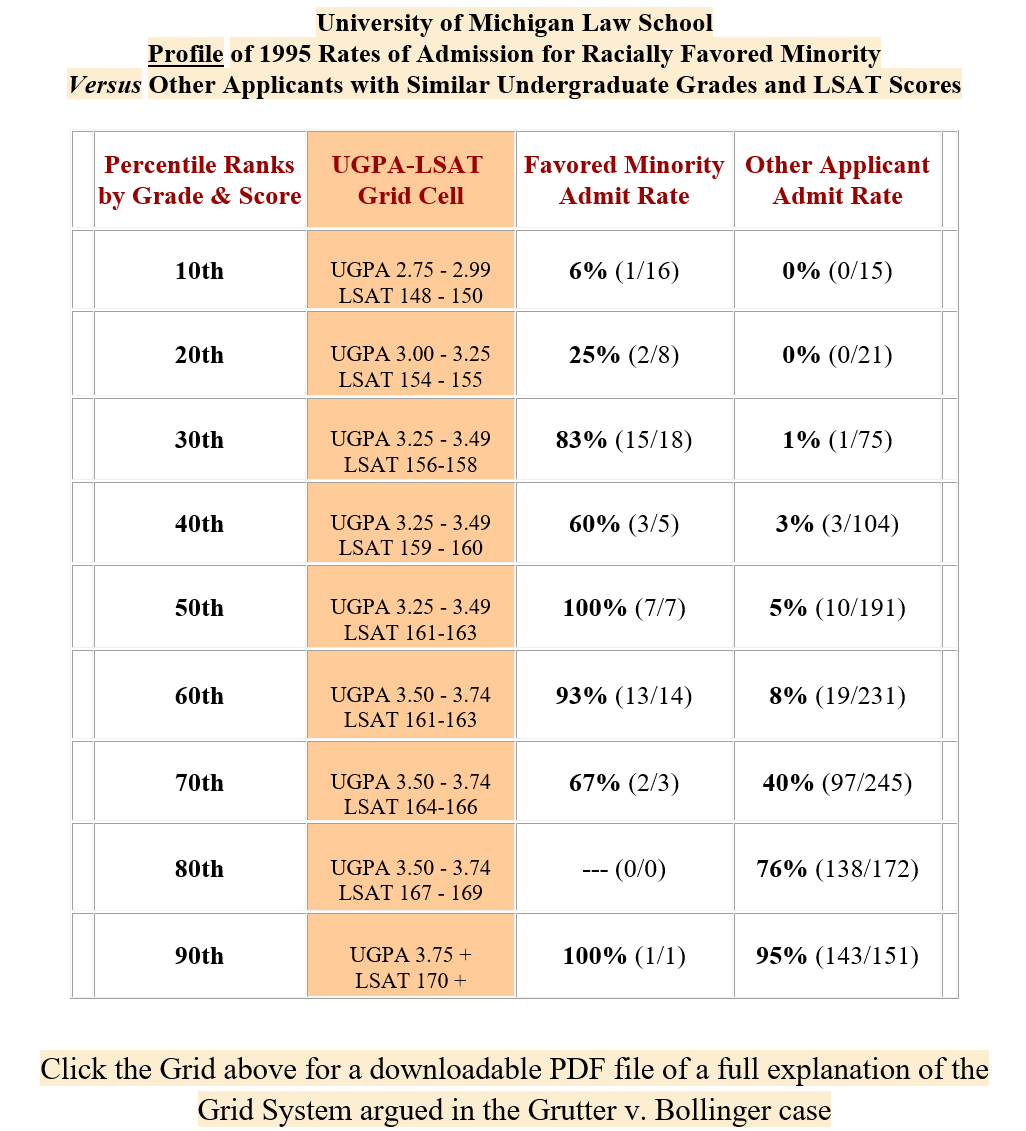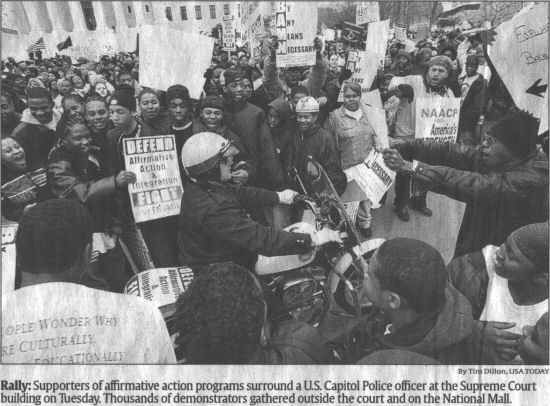Outline of the University of Michigan
Law School
Affirmative Action Trial
Grutter v. Bollinger:
The trial took place in Detroit in the United States District Court for the Eastern District of Michigan before US District Judge Bernard Friedman. The trial lasted fifteen days, between January 16 and February 16, 2001, with the last day taken up by closing arguments. Each of the three parties was allowed 30 hours to present its case, but only the Students Intervenors used all their allotted time.
(From BAMN’s Liberator #1 – Used to organize for the historic Grutter v. Bollinger trial)

PLAINTIFF Barbara Grutter, et al. (Center for Individual Rights [CIR], anti-affirmative action).
*3 witnesses called: Allan Stillwagon, Erica Munzel, and Kinley Larntz. CIR spent 3 days presenting their positive case.
*CIR’s total presentation before closing argument, including cross-examination, was 19 hours and 23 minutes (of 30-hour limit). Barbara Grutter herself never testified.
DEFENDANT (University of Michigan Law School) Lee Bollinger, et al. (pro-affirmative action).
*6 witnesses called: Lee Bollinger, Richard Lempert (also witness for the Student Intervenors), Dennis Shields, Stephen W. Raudenbush, Kent Syverud, and Jeffrey Lehman. The University spent 3 days presenting its positive case.
*The University s total presentation before closing argument, including cross-examination, was 15 hours and 50 minutes (of 30-hour limit).
INTERVENING DEFENDANTS (the Student Intervenors) Kimberly James, et al. (pro-affirmative action) – 41 Named Individual Students, the Coalition to Defend Affirmative Action and Integration, and Fight for Equality By Any Means Necessary [BAMN], United for Equality and Affirmative Action [UEAA], Law Students for Affirmative Action [LSAA].
*15 witnesses called: Erika Dowdell, Gary Orfield, John Hope Franklin, Jay Rosner, Martin Shapiro, Concepcion Escobar, Chrystal James, Walter
*Allen, Eugene Garcia, Eric Foner, David White, Frank Wu, Faith Smith, Richard Lempert (also witness for the University), and Tania Kappner. The Student Intervenors spent 8 days presenting their positive case. The Student Intervenors total presentation before closing argument, including cross-examination, was 28 hours and 48 minutes (of 30-hour limit).
DAY 1 MOTIONS, OPENING STATEMENTS, BEGINNING OF TRIAL WITH CIR’S CASE. Tuesday, January 16
- Allan Stillwagon, disgruntled former director of admissions at the UM Law School from 1979 to 1990, before the current Law School admissions policy was developed, testified that under this past admissions policy there was a target goal of 10-12% underrepresented minority enrollment.
- Erica Munzel, the current director of admissions to the UM Law School testified that there is no quota or target goal for minority students at the Law School under the current admissions policy, adopted in 1992. CIR spent half the day asking her the same basic question in various forms, trying by implication and innuendo to create the impression that the current policy is really the same as the policy under Stillwagon, despite Munzel’s repeated denial.
DAY 2 CIR CASE CONTINUED Wednesday, January 17
- Kinley Larntz, a disingenuous CIR statistician, testified to having performed statistical analysis of a group of UM Law School applicants. Larntz asserted that, holding grades and LSAT scores constant, students who benefited from affirmative action were more likely to be admitted. He reduced this to a figure called an “odds ratio” that gave an astronomically enormous appearance to the weight of affirmative action in the Law School’s admissions. CIR used these statistics to claim that the current admissions policy contains a hidden quota for minority students.
DAY 3 END OF CIR CASE; BEGINNING OF UNIVERSITY’S CASE Thursday, January 18
- Lee Bollinger, president of the University of Michigan since 1997 and Dean of the UM Law School 1987 to 1994 testified that the UM Law school admissions system uses neither quotas nor target goals for admissions of minority students. He talked about the value of diversity to the tradition of liberal education.
- Richard Lempert, UM Law professor and sociologist, testified for both the University and for the Student Intervenors. Lempert was chair of the Law School admissions committee that designed the current admissions policy under attack by CIR. He testified that the goal of the Law School admissions policy is to admit a whole class that is diverse and that is stronger than the sum of its parts, without any use of quotas or target goals. hidden or otherwise.
DAY 4 UNIVERSITY S CASE CONTINUED Friday, January 19
- Stephen W. Raudenbush, a University statistician, testified that the plaintiff’s statistical approach to expressing the admissions information was flawed, and misleading. He criticized the plaintiff’s approach for discarding a substantial part of the relevant information and various other methodological problems.
- Dennis Shields, the former Director of Admissions for the UM Law School, testified to recruiting students to apply from a wide range of institutions. He testified to doing outreach for minority applicants and gave a job description of an admissions officer. He testified to the substantial overlap in admissions criteria for minority and majority applicants.
DAY 5 END OF UNIVERSITY’S CASE Monday, January 22
- Kent Syverud, Dean of the Vanderbilt Law School in Nashville, Tennessee, testified about the pedagogy of Law School and the benefits of diversity. He asserted that under particular conditions a critical mass of black students could be a single student.
- Jeffrey Lehman, Dean of the University of Michigan Law School, testified to the fact that the Law School does not have a quota for minority students. He testified to the fact that the minority students in the UM Law School classes he teaches are the peers and equals of the majority students and argued from his own experience how important ethnic diversity is to the educational mission of the Law School.
DAY 6 BEGINNING OF STUDENT INTERVENOR’S CASE Tuesday, January 23
- Erika Dowdell, a black junior at the University of Michigan in the school of Literature, Science and the Arts, a graduate of Cass Technical High School in Detroit, and herself a named defendant in the case, opened up the student intervenors case by testifying to the segregated and unequal conditions of the primary and secondary schooling she received in Detroit. Her testimony was some of the most riveting and powerful of the entire trial. She communicated the overwhelming force of character necessary to overcome the obstacles of racism, segregation, and stigma that she and millions of other students face. She made clear she would not attend a resegregated Law School.
- Gary Orfield, director of the Harvard University Civil Rights Project, testified to the profound and continuing significance of race and segregation to American education. His knowledge of social policy and education policy was vast. He made clear how federal housing policy had dramatically increased residential segregation in the Detroit area, and how that connected with the intensely segregated conditions of education in Michigan.
DAY 7 STUDENT INTERVENORS CASE CONTINUED Wednesday, January 24
- John Hope Franklin, one of America’s foremost historians and Co-chair of the President’s Initiative on Race, testified about race relations throughout the Twentieth Century. He testified both as a historian and from his own personal experience for five hours straight on subjects ranging from the Tulsa, Oklahoma race riots, to the improvisational character of Jim Crow segregation, to profound anecdotes about his recent personal experience of racism. His testimony made clear that racism in American history has been directed at black and other minority people, not at white people.
- Jay Rosner, the director of the Princeton Review Foundation testified to the narrowness of test-taking skills, the biases involved in standardized tests like the SAT and LSAT, the limited usefulness of the tests as indicators of qualifications for law students and to the substantial LSAT score improvement that test preparation courses provide.
Break, Thursday, January 25 through Monday, February 5, 2001
DAY 8 STUDENT INTERVENOR’S CASE CONTINUED Tuesday, February 6
- Martin Shapiro, a professor of psychology at Emory University in Atlanta testified to the disparate impact of the LSAT and standardized tests generally on black and other minority students. He explained how this phenomenon is endlessly reproduced through the process of test question selection.
[4.] Jay Rosner (continued). Mr. Rosner finished his testimony, including additional description of the biases in the process of test preparation for tests like the SAT and LSAT.
- Conception Escobar, a Latina and Native American first year UM law student who went to segregated Chicago public schools and then to Amherst College in Massachusetts, testified about the prejudice and racist stereotypes with which she had to contend in her undergraduate education and how those influenced her academic performance. Her testimony of struggling to overcome racism and poverty moved many in the courtroom to tears.
DAY 9 STUDENT INTERVENOR’S CASE CONTINUED Wednesday, February 7
- Chrystal James, one of two black second-year UCLA law students, in the wake of the prohibition of affirmative action in California by Proposition 209. James testified to the dramatic increase in racist stigma after the elimination of affirmative action in California caused the resegregation of the UC system and it’s professional schools. She testified with immense force and energy about her struggle to acquire a legal education under resegregated conditions. Her testimony was exceptionally compelling.
- Walter Allen, a nationally recognized UCLA sociologist who was asked by the student intervenors to head up a study of the racial climate on four of the main UM Law School undergraduate feeder campuses. Allen testified extensively about the hostile environment experienced by minority students on these campuses and the impact of that environment on academic achievement. He testified both about his research findings from the study commissioned by the intervenors and about his many years of research concerning the sociology of race and education. His testimony made clear that law school admissions criteria such as undergraduate GPA s, like LSAT scores, are distorted by the biases in the campus climate.
DAY 10 STUDENT INTERVENOR’S CASE CONTINUED Thursday, February 8
[8.] Walter Allen (continued). Allen completed his testimony, explaining his research methods and aggressively defending his research and its implications.
- Eugene Garcia (begun), the Dean of the Graduate School of Education at the University of California at Berkeley, testified to the increasingly segregated and unequal conditions of education, in particular for Latino/Chicano and black youth in K-12 education in California and around the nation. He testified to the growing resegregation of the UC system and its implications for the future of the state of California. Dean Garcia also spoke at length about the particular problems of discrimination experienced by Latino/as and the special disadvantage of all students who do not learn academic English in their homes.
- Eric Foner, America’s leading historian of the Reconstruction period gave a profound, clear, terse exposition of American history from the standpoint of the central theme of racism and the struggle for black equality. In just over two hours he gave the best oral presentation of the significance of race in American history ever presented in an American courtroom. His testimony made clear that throughout our history there has been a double standard against black people and that as a result, black and white Americans have experienced their own shared history in very different ways.
DAY 11 STUDENT INTERVENOR’S CASE CONTINUED Friday, February 9
[9.] Eugene Garcia (continued). In the conclusion of his testimony, based on his own experience of Proposition 209 in California, Dean Garcia made clear the significance of this vast, misguided social experiment in eliminating affirmative action in a society still as mired in racist inequality and segregation as ours is. Dean Garcia presented an eloquent plea to the courtroom that Michigan not repeat the terrible mistake made in
California.
- David White, the Director and founder of Testing for the Public and the leading national expert on the racial bias of the LSAT, testified to the nature, extent and causes of the disparate impact of the LSAT on black, Latina/o, Native American and Asian Pacific American students.
DAY 12 CIR REBUTTAL WITNESS Saturday, February 10
[3.] Kinley Larntz, (again). On rebuttal, the CIR statistician, responded to University statistician Stephen W. Raudenbush’s claims that his statistical method had discarded a very substantial portion of the relevant information. Larntz then presented the discarded information in a misleading fashion.
DAY 13 UNIVERSITY’S REBUTTAL, STUDENT INTERVENORS CASE CONTINUED Monday, February 12
[4.] Stephen W. Raudenbush, the University statistician, testified that Larntz’s approach could produce the exact same odds ratio for minority/white admissions in two admissions policy models, one in which race was a vast factor, and one in which it was a negligible factor.
- Frank Wu, a professor of law at Howard University and an expert on the impact of affirmative action on Asian Pacific Americans, testified to the ways in which APA’s have benefited from affirmative action. He systematically explicated and attacked the racism and racist stereotypes directed at Asian Americans. Professor Wu pointed out that his was the first testimony ever heard in affirmative action litigation from an Asian person, despite the frequency of reference to Asian Americans in the social and legal debate over affirmative action.
- Faith Smith, the Dean of the only Native American-run college in the country, testified to the particular social conditions and educational challenges that Native Americans face. She described the racism and social inequality that characterize conditions for Native Americans on and off reservations. She testified to the critical importance of affirmative action for offsetting the effect of racism on the Native American students.
DAY 14 END OF STUDENT INTERVENORS CASE Thursday, February 15
- Richard Lempert, UM Law professor and sociologist, who also testified earlier for the University, described the results of an extensive study that he supervised comparing the career experience of black and white UM Law School graduates. He testified that his study found no significant difference in career performance between black and white Law School graduates other than that black graduates tended to do slightly more community service-type work upon graduation.
- Tania Kappner, an Oakland, California teacher and recent UC Berkeley Education School graduate, testified with unmistakable passion about how the high school youth whom she teaches had been negatively effected by the elimination of affirmative action in California. She described the growing movement to defend affirmative action and the struggle to force the UC Regents to reverse the ban on affirmative action in the UC system.
DAY 15 CLOSING ARGUMENTS, TRIAL ENDS Friday, February 16
CIR. Attorney Kirk Kolbo’s closing argument was a summation of their case in plain terms. Fundamentally, Kolbo presented the CIR

position that the US Supreme Court’s 1978 Bakke decision is not good law and should be overturned. But CIR also argued that, under Bakke, the UM Law School’s extremely modest affirmative action policy still constitutes a hidden quota and a double standard and should be found unconstitutional. CIR asserted that the University wanted to simultaneously diminish the significance of race by saying that race was just one factor among many (one student could be a critical mass) and yet make much of the significance of race by saying that the Law School would be resegregated if affirmative action was barred.
University Attorney John Payton’s closing statement for the University’s closing statement kept meticulously and cautiously close to the Bakke script: race is one factor among many that is used in admissions to further the educational goals of diversity. They said that their admissions policy was written with precisely the Bakke precedent as its model and the Harvard admissions system that the Bakke opinion refers to approvingly. The University asserted that, essentially, if its Law School s affirmative action policy cannot withstand a Bakke challenge, then none could, and Bakke itself is a dead letter.
Student Intervenors’ Attorney Miranda Massie’s closing for the intervenors began with a reminder of the heroism of the struggle for equality and integration in American education. The intervenors motivated affirmative action from the standpoint of the need for a desegregation plan for the UM Law School. The intervenors addressed each of the three questions that Judge Friedman had posed for the trial. In response to the first question “How much is race used in admissions?” The Student Intervenors answered that race is not taken account of sufficiently to offset the impact on the admissions process of the racism of American society and in education in particular. In response to the Judges second question, “Is there a double standard in admissions to the UM Law School?”, The Students Intervenors responded yes, there is a double standard that favors white applicants. To the question whether affirmative action offsets the bias in the LSAT and in undergraduate GPA s, the Student Intervenors said yes, but not enough. The Student Intervenors asked Judge Freidman to rule in a way that would move American society forward toward greater equality and integration.
For a full list of the transcripts used in the trial of Grutter v. Bollinger, click this link
DEFEND AFFIRMATIVE ACTION PARTY (DAAP) Paid for by daap@umich.edu
